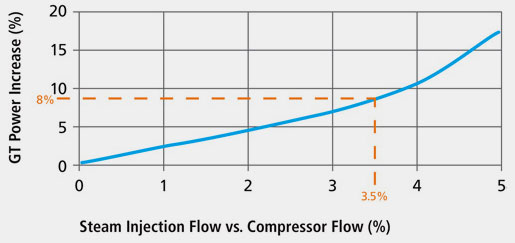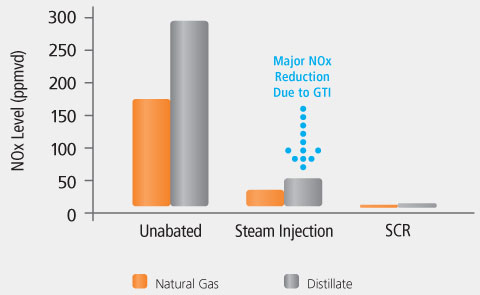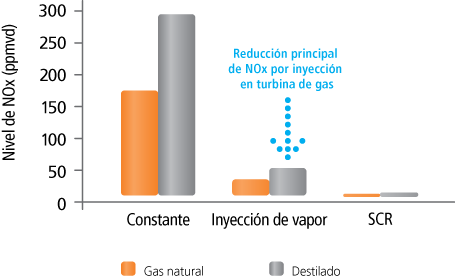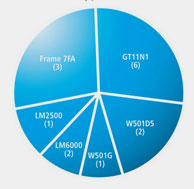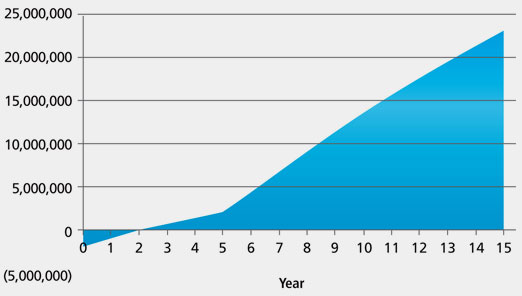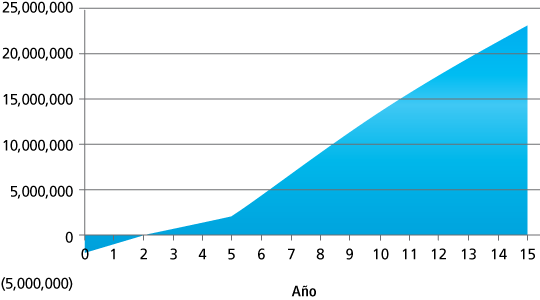FAQ
1. ¿Qué es GTI?
- GTI es el turbosobrealimentador para su turbina de gas.
- GTI aumenta la potencia de la turbina de gas y reduce los niveles de NOx.
- El ciclo de GTI / STIG toma el calor residual de la turbina de gas, convierte el agua en vapor y luego inyecta ese vapor en la turbina de gas.
1. What is GTI?
- GTI is the turbocharger for your gas turbine.
- GTI increases the power of the GT and lowers the NOx levels.
- The GTI / STIG cycle takes waste heat from the gas turbine, converts water into steam and then injects this steam into the gas turbine.
1. What is GTI?
- GTI is the turbocharger for your gas turbine.
- GTI increases the power of the GT and lowers the NOx levels.
- The GTI / STIG cycle takes waste heat from the gas turbine, converts water into steam and then injects this steam into the gas turbine.
2. What are the benefits of GTI?
GTI provides several benefits: power augmentation, fuel savings and emissions reduction
- Power can be increased by more than 15%.
- Fuel consumption can be reduced by 18%.
- NOx emissions are reduced by up to 80% (based on non abated NOx emissions).
- CO emissions are reduced.
- 2a. GTI for Power Augmentation duction

- 2a. GTI for Power Augmentation duction
- Gas turbines are designed to allow steam injection levels of up to 5% of the compressor airflow with flows as high as 10% allowed on some GTs.
- Steam injection can increase power output by approximately 18% for all ambient conditions (independent of temperature, humidity etc.).
-
- 2b. GTI for Nox Reduction

- 2b. GTI for Nox Reduction
- GTI will substantially reduce gas turbine unabated NOx levels.
2. ¿Cuáles son los beneficios de GTI?
GTI brinda varios beneficios: incremento de la potencia, ahorro de combustible y reducción de emisiones.
- El incremento de la potencia puede ser de más del 15%.
- El consumo de combustible puede reducirse en un 18%.
- Las emisiones de NOx se reducen hasta en un 80% (tomando en cuenta las emisiones constantes de NOx).
- Se reducen las emisiones de CO.
- 2A. GTI para incrementar la potencia

- Las turbinas de gas están diseñadas para permitir niveles de inyección de vapor de hasta el 5% del caudal de aire del compresor con corrientes de hasta el 10% permitido en algunas turbinas de gas.
- La inyecci?n de vapor puede incrementar la potencia de salida en aproximadamente un 18% para todas las condiciones ambientales (independientemente de la temperatura, la humedad, etc.).
- 2B. GTI para reducir los NOx

- GTI reducirá de manera considerable los niveles constantes de NOx de la turbina de gas.
2. What are the benefits of GTI?
GTI provides several benefits: power augmentation, fuel savings and emissions reduction
- Power can be increased by more than 15%.
- Fuel consumption can be reduced by 18%.
- NOx emissions are reduced by up to 80% (based on non abated NOx emissions).
- CO emissions are reduced.
- 2a. GTI for Power Augmentation duction

- 2a. GTI for Power Augmentation duction
- Gas turbines are designed to allow steam injection levels of up to 5% of the compressor airflow with flows as high as 10% allowed on some GTs.
- Steam injection can increase power output by approximately 18% for all ambient conditions (independent of temperature, humidity etc.).
-
- 2b. GTI for Nox Reduction

- 2b. GTI for Nox Reduction
- GTI will substantially reduce gas turbine unabated NOx levels.
3. How does GTI work?
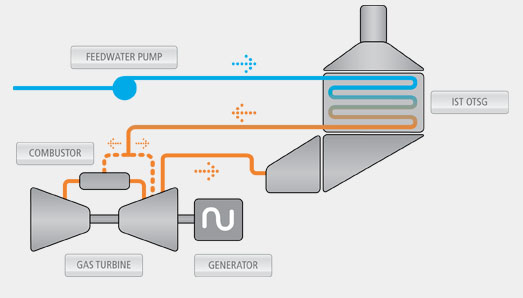
- Steam is injected into the combustors and power turbine to increase the mass flow, which then results in increased power output.
- The steam also provides a thermal heat sink in the combustor that lowers the temprature reducing the creation of thermal NOx.
3. ¿Cómo funciona GTI?
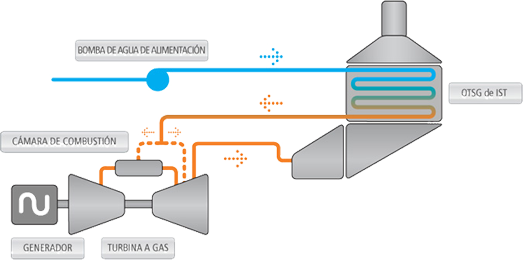
- El vapor se inyecta en las cámaras de combustión y en la turbina de potencia para incrementar el flujo másico, lo cual produce una mayor potencia de salida.
- Además, el vapor proporciona un disipador térmico en la cámara de combustión que baja la temperatura y disminuye la producción de NOx térmico.
3. How does GTI work?

- Steam is injected into the combustors and power turbine to increase the mass flow, which then results in increased power output.
- The steam also provides a thermal heat sink in the combustor that lowers the temprature reducing the creation of thermal NOx.
4. Where has GTI been implemented?
- IST has 15 installations
- IST has performed GTI on most GT types
3-Frame 7FA
6-GT 11N1
1-LM2500
2-LM6000
1-W501G
2-W501D5

4. ¿Dónde se ha aplicado GTI?
- IST ha realizado 15 instalaciones
- IST ha realizado GTI en la mayoría de los tipos de turbinas de gas
3-Frame 7FA
6-GT 11N1
1-LM2500
2-LM6000
1-W501G
2-W501D5

4. Where has GTI been implemented?
- IST has 15 installations
- IST has performed GTI on most GT types
3-Frame 7FA
6-GT 11N1
1-LM2500
2-LM6000
1-W501G
2-W501D5

5. Do I need to make special modifications to my plant?
- Most gas turbines will accept 5% steam injection without major modifications. One required change is the addition of steam ports on the GT combustors. Often these parts are already pre-installed. Most manufacturers have kits available which make this change very straight forward.
- IST can help you develop a scope of work and a budget for your plant.
- Additionally, IST can coordinate the full retrofit.
5. ¿Debo hacer modificaciones especiales en mi planta?
- La mayoría de las turbinas de gas aceptan una inyección de vapor del 5% sin necesidad de modificaciones importantes. Un cambio necesario es el agregado de orificios de salida para el vapor en las cámaras de combustión de la turbina de gas. Estas piezas suelen estar ya preinstaladas. La mayoría de los fabricantes ofrecen equipos para realizar ese cambio de manera muy sencilla.
- IST le permite desarrollar un plan de trabajo y un presupuesto para su planta.
- Además, IST puede coordinar toda la reconversión.
5. Do I need to make special modifications to my plant?
- Most gas turbines will accept 5% steam injection without major modifications. One required change is the addition of steam ports on the GT combustors. Often these parts are already pre-installed. Most manufacturers have kits available which make this change very straight forward.
- IST can help you develop a scope of work and a budget for your plant.
- Additionally, IST can coordinate the full retrofit.
6. How long will GTI take to install?
- A GTI retrofit requires very little downtime.
- Total project install takes typically 3 weeks including
commissioning and start-up. - GT outage is approximately 5 days.
- Minimal crane and supervision hours, are required.
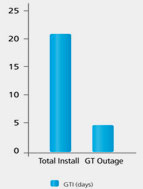
6. ¿Cuánto tiempo demora la instalación de GTI?
- Una reconversión de GTI requiere muy poco tiempo improductivo.
- La instalación total del proyecto demora generalmente 3 semanas incluyendo la puesta en marcha y en servicio.
- La interrupción del funcionamiento de la turbina de gas es de aproximadamente 5 d?as.
- Se necesitan muy pocas horas de grúa y supervisión.
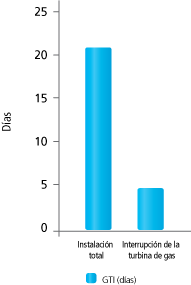
6. How long will GTI take to install?
- A GTI retrofit requires very little downtime.
- Total project install takes typically 3 weeks including
commissioning and start-up. - GT outage is approximately 5 days.
- Minimal crane and supervision hours, are required.

7. When will I see a payback from GTI?
- All projects are unique, however, a GTI retrofit on average has a payback of 2 to 5 years.

7. ¿Cuándo recuperaré la inversión de GTI?
- Todos los proyectos son únicos. Sin embargo, una reconversión de GTI en promedio permite recuperar la inversión de 2 a 5 años.

7. When will I see a payback from GTI?
- All projects are unique, however, a GTI retrofit on average has a payback of 2 to 5 years.

8. Will steam injection damage my gas turbine?
- The application of steam injection can occur at various injection levels. In general, at levels less than 5%, wear and tear on the turbine is negligable.
- Additionally, any increased maintenance that is required is greatly over shadowed by the increase in net power and the reduction in fuel use.
8. ¿La inyección de vapor puede dañar mi turbina de gas?
- La aplicación de la inyección de vapor puede producirse en varios niveles. En general, en niveles menores al 5%, el desgaste de la turbina es mínimo.
- Además, cualquier mantenimiento mayor que se necesite pierde su importancia ante el incremento de la potencia neta y la disminución en el uso de combustible.
8. Will steam injection damage my gas turbine?
- The application of steam injection can occur at various injection levels. In general, at levels less than 5%, wear and tear on the turbine is negligable.
- Additionally, any increased maintenance that is required is greatly over shadowed by the increase in net power and the reduction in fuel use.
9. How much water will I need to supply for steam injection?
- Each gas turbine will require a unique amount of water supply based on the steam injection rate.
- For the Frame 7FA, with an air mass flow = 3,381,000 lbs/hr and based on 5% steam injection:The amount of water required is: 3,381,000 lbs/hr x .05 = 169,050 lbs/hr steam = 169,050 lbs/hr water
- This equates to 337.5 GPM.
9. ¿Qué cantidad de agua necesito para la inyección de vapor?
- Cada turbina de gas necesita una cantidad de agua diferente según la proporción de la inyección de vapor.
- Para el armazón 7FA, con un flujo másico de aire = 3,381,000 lbs/hr y con una inyección de vapor de 5%: la cantidad de agua que se necesita es: 3,381,000 lbs/hr x .05 = 169,050 lbs/hr de vapor= 169,050 lbs/hr de agua
- Esto equivale a 337.5 GPM.
9. How much water will I need to supply for steam injection?
- Each gas turbine will require a unique amount of water supply based on the steam injection rate.
- For the Frame 7FA, with an air mass flow = 3,381,000 lbs/hr and based on 5% steam injection:The amount of water required is: 3,381,000 lbs/hr x .05 = 169,050 lbs/hr steam = 169,050 lbs/hr water
- This equates to 337.5 GPM.
10. What is the feed water purity/quality required for the cycle?
- The water required for the GTI should meet todays standards that would ensure unaffected life span for all plant equipment and components.
- Treatment of the water is very simple and not costly.
- Control of the water chemistry can be automated.
10. ¿Qué pureza/calidad de agua de alimentación se necesita para el ciclo?
- El agua que se necesita para la GTI debe cumplir con las normas actuales que aseguren una vida útil sin alteraciones para todos los equipos y componentes de la planta.
- El tratamiento del agua es muy simple y nada costoso.
- El control de la química del agua puede automatizarse.
10. What is the feed water purity/quality required for the cycle?
- The water required for the GTI should meet todays standards that would ensure unaffected life span for all plant equipment and components.
- Treatment of the water is very simple and not costly.
- Control of the water chemistry can be automated.
11. What is the dry running limit for the GTI?
- The GTI can be engineered to fit the exhaust temperature of your gas turbine.
- We have manufactured units suitable for 1100F, 1200F and 1300F dry running capability.
11. ¿Cuál es el límite de funcionamiento en seco para la GTI?
- La GTI puede diseñarse para adecuarse a la temperatura de escape de su turbina de gas.
- Fabricamos unidades compatibles con la capacidad de funcionamiento en seco de 1100° F, 1200° F y 1300° F.
11. What is the dry running limit for the GTI?
- The GTI can be engineered to fit the exhaust temperature of your gas turbine.
- We have manufactured units suitable for 1100F, 1200F and 1300F dry running capability.
12. Why not water injection?
- Water injection is in principal like steam injection however, it is not as efficient for power augmentation or NOx control.
- Water when it is injected into the GT combustor absorbs more heat energy than steam. The resulting loss of energy robs power from the GT thus making it less efficient.
12. ¿Por qué no la inyección de agua?
- En principio, la inyección de agua es similar a la inyección de vapor. Sin embargo no resulta tan eficaz en cuanto al incremento de la potencia o al control de NOx.
- Cuando el agua se inyecta en la cámara de combustión de la turbina de gas, absorbe más energía térmica que el vapor. La pérdida de energía resultante le quita potencia a la turbina de gas y, por lo tanto, hace que sea menos eficaz.
12. Why not water injection?
- Water injection is in principal like steam injection however, it is not as efficient for power augmentation or NOx control.
- Water when it is injected into the GT combustor absorbs more heat energy than steam. The resulting loss of energy robs power from the GT thus making it less efficient.
13. Is my gas turbine designed for steam injection?
- Almost all gas turbines can accept steam injection.
- The most suitable GTs are newer frame units, however IST has steam injection designs for all the major GT types.
13. ¿Mi turbina de gas está diseñada para la inyección de vapor?
- Casi todas las turbinas de gas admiten la inyección de vapor.
- Si bien las turbinas de gas más adecuadas son las unidades de armazones más nuevas, IST cuenta con diseños de inyección de vapor para todos los principales tipos de turbinas de gas.
13. Is my gas turbine designed for steam injection?
- Almost all gas turbines can accept steam injection.
- The most suitable GTs are newer frame units, however IST has steam injection designs for all the major GT types.

 IST
IST
